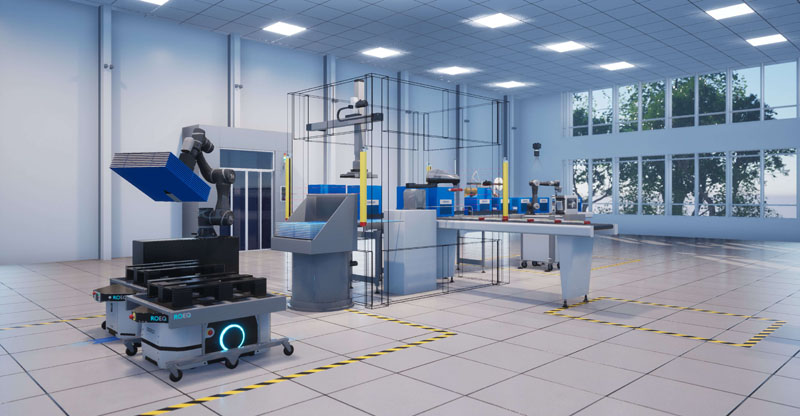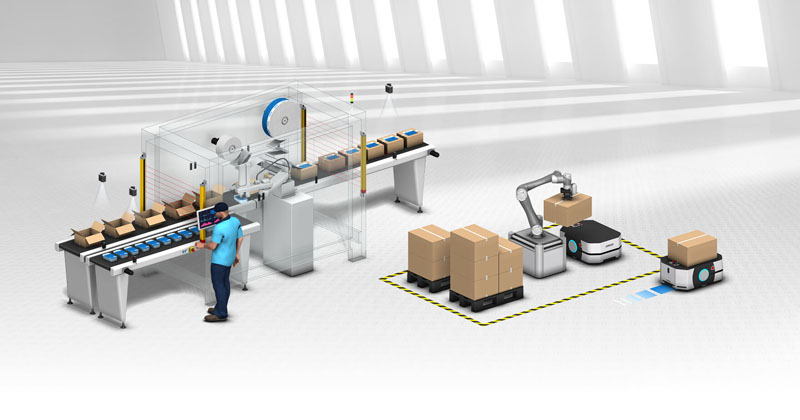Despite automation offering clear solutions, the UK is currently ranked 24th in terms of the number of robots utilised per every 10,000 manufacturing workers.
During a recent OMRON webinar, Stuart Coulton, the company’s UK and Ireland marketing manager, and George Brown, technical services manager for robotics, safety and vision, argued that it was time to change all that.
“There are clear issues that we need to address, and advanced solutions can play a pivotal role in helping UK manufacturing to overcome some of these,” said Coulton. “There are some really easy wins with simple applications of automation.”
From manual to automated feeding
One of these areas is feeding, the majority of which, Brown explained, is still done manually.
“Moving a product from bulk storage onto a machine can be a mundane, repetitive job. It puts a lot of physical stress on the operator and makes them vulnerable to repetitive strain and ergonomics injuries," he said, adding that this made it a difficult role to recruit for.
Manual feeding also presents operational challenges. It limits production to working hours, for example, and human error is inevitable, particularly when facilities are understaffed.
This can lead to quality issues or unplanned slowdowns and stoppages, all of which can impact on the bottom line.

Said Coulton: “It is very expensive now to produce things in the UK. A key reason for this is that we are, compared with other economies, still very reliant on human labour to fulfil certain tasks. It really does make sense for us to start to look at automated feeding and robotics as a viable solution.”
Automated feeding involves using robotics to move goods or components to machinery for further processing.
It can improve overall operational efficiency (OEE) in a number of ways. It removes manual stress from workers, increases production time from working hours to 24/7, and introduces a consistency that enhances quality.
Collaborative robots (cobots), which work alongside human workers, can be easily programmed to move between processes, increasing cycle time and boosting throughput.
Some cobots incorporate vision sensors that allow them to identify “landmarks,” or physical objects that help them navigate and locate themselves.
Some traditional forms of robotics have been prohibitively expensive, requiring factory refurbishments and detailed programming skills to set up and manage. Advanced, modern cobots, however, are different.
They have no rails, operating independently, and easily integrate with existing machinery. They are relatively affordable, and their ability to seamlessly move between machines and lines accelerates their ROI.

Training employees to programme and deploy cobots is quick and straightforward, meaning they do not tend to require advanced in-house skillsets. In terms of safety, they feature a ‘collaborative mode’, which slows the cobot’s movement speed if its human colleagues get close.
In addition, said Brown, adopting robotics enhances a manufacturers’ reputation as an innovative organisation, helping to attract employees and clients alike.
Adoption top tips
Robotic adoption may seem like a daunting process ... but it doesn’t have to be.
Brown said: “The key thing is not to jump in at the deep end. Think about what the most possible, feasible applications might be and go from there.”
Organisations can scale-up their automation programmes as and when they achieve ROI, he added.
“It introduces scalability. It might be that you have three operators doing feeding in one area, so perhaps you start off with one cobot and two staff. You make sure the technology fits and operates, then maybe the second robot comes in, and you can deploy your operators elsewhere.”
Change management is also important. "Taking people with you," he said, was key to ensuring acceptance on the factory floor.
That includes involving staff in the use case selection and implementation plans, and demonstrating how the technology is intended to assist, not replace, them.
Crucially, any manufacturing operation considering adopting automated feeding should talk to the experts.
“We can work with you on proof-of-concept studies and we can walk the line with you to understand your pain points. Ultimately, we can help you to match the right technology to your challenges, and help you plan the right route to success,” said Brown.
Bibliography
-
https://industrial.omron.co.uk/en/news-events/events/transforming-manufacturing-on-demand.
- https://www.foodmanufacture.co.uk/Article/2023/07/04/UK-manufacturing-job-vacancies-drop-to-74-000.
- https://engineering-update.co.uk/2023/02/02/global-robot-report-highlights-uks-urgent-need-to-increase-automation-engineering-global-robotreport/.
